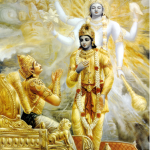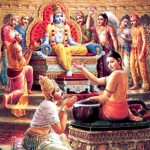Bhagavad Gita Chapter 6 Summary – Dhyana Yoga – In chapter 5 of the Bhagavad Gita, Lord Krishna describes how to attain perfection by Niskama karma yoga or work without expectation of return. In the sixth chapter, Krishna explains the process of Ashtanga yoga or meditation as a means to control one’s mind and senses. We will divide this chapter into various sections and analyze the sections in depth.
Table of Contents
Niskama karma yoga ( BG 6.1 – 6.2 )
In the beginning few verses of the sixth chapter, Lord Krishna explains the importance of purifying oneself by the process of Niskama karma yoga before trying the meditation process, which is difficult for people in general. In his purport to verse 1 of the sixth chapter of Bhagavad Gita as it is, Srila Prabhupada explains that real perfection is to act for the satisfaction of Krishna or the Supreme whole.
This process known as Niskama karma yoga is practical. He explains that everybody in this world acts for some selfish interest. Even a sanyasi who is interested in becoming one with the Supreme or a mystic yogi who performs severe penances are not free from selfish desire. Even desiring liberation for oneself is to be construed as a selfish desire. On the other hand, a devotee or a Krishna conscious person works only for the satisfaction of Krishna and has no selfish motives. Such a devotee can be called a perfect sanyasi or yogi.
Two levels of Ashtanga yoga ( BG 6.3 – 6.4)
Lord Krishna talks about two levels of Ashtanga yoga – Yoga aruruksa (beginning stage) and Yoga-arudha (advanced stage). In the beginning stage, one should first cultivate detachment by performing one’s prescribed duties and simultaneously perform Ashtanga yoga by practicing asanas. This leads to gradual purification of the heart. Thus, when one is completely purified of material desires, i.e. in the advanced stage, one can practice Ashtanga yoga exclusively. In this advanced stage, the stage of steady meditation or dhyana, one attains perfect mental equilibrium to control the senses.
In his purport to the verse 3 of the sixth chapter of Bhagavad Gita as it is, Srila Prabhupada explains that a Krishna conscious person or a devotee of Lord Krishna is situated in the advanced stage of meditation right from the beginning as he always thinks of pleasing Krishna. As he is constantly engaged in the service of Krishna, he is considered to have already ceased all material activities. On the other hand, a yogi who is not a devotee of Krishna must resort to mechanical processes such as gymnastics to escape the onslaught of material desires
Mind control and detachment ( BG 6.5 – 6.10)
Mind control and detachment from sense objects are the requirements to come to the advanced stage of Ashtanga yoga. So, Lord Krishna begins to explain the importance of mind control. Lord Krishna explains that one should deliver oneself by one’s mind and not be degraded (by the distracted senses). He declares in BG 6.6 that the controlled mind is the friend of the soul while the uncontrolled mind is the enemy. He explains that the mind is the best friend for one who has conquered it; the mind will remain the worst enemy for one who has failed to conquer it.
In his purport to verse 5 of the sixth chapter of Bhagavad Gita as it is, Srila Prabhupada explains that the more one is attracted to sense objects, the more one becomes entangled in this material world. He concludes the purport in this way – “The best way to disentangle oneself is to always engage the mind in Krishna consciousness”.
In his purport to verse 6 of the sixth chapter of Bhagavad Gita as it is, Srila Prabhupada explains that, as along as the mind remains unconquered, one has to serve the dictations of lust, anger, avarice, illusion etc. But when the mind is completely conquered, one voluntarily agrees to abide by the dictation of the Personality of Godhead, who is situated as the Paramatma within everyone’s heart. Srila Prabhupada concludes that the real goal of Ashtanga yoga practice is to meet the Paramatma within the heart and then follow His dictation.
Lord Krishna explains the symptoms of one with a controlled mind in BG 6.8-9– to such a person, happiness and distress, heat and cold, honor and dishonor are all the same. He sees everything – whether it be pebbles, stones or gold as the same. He is considered still further advanced when he regards honest well-wishers, affectionate benefactors, the neutral, mediators, the envious, friends and enemies, the pious and sinners all with an equal mind.
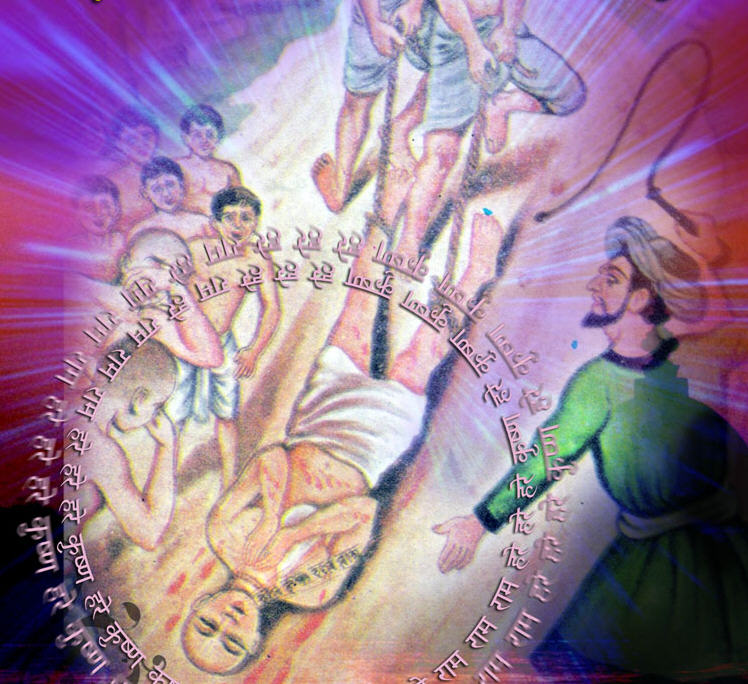
Method of preparation ( BG 6.11 – 6.12 )
Lord Krishna explains the method of preparation for meditation or dhyana yoga in BG 6.11 -12- “To practice yoga, one should go to a secluded place and should lay kusa grass on the ground and then cover it with a deerskin and a soft cloth. The seat should be neither too high nor too low and should be situated in a sacred place. The yogi should then sit on it very firmly and practise yoga to purify the heart by controlling his mind, senses and activities and fixing the mind on one point”
In his purport to the verses 11 and 12 of the sixth chapter of Bhagavad Gita as it is, Srila Prabhupada explains that these conditions are difficult to fulfill for people in general, especially those living in big cities. The yoga societies situated in the hustle and bustle of the big cities, Srila Prabhupada explains, thus fail to provide a secluded, peaceful, and undisturbing atmosphere to the meditator. He explains that the easiest form of meditation for the ever-disturbed people of Kali Yuga is the chanting of the Holy Names of Lord Krishna or the Hare Krishna Mahamantra.
” Hare Kṛṣṇa Hare Kṛṣṇa Kṛṣṇa Kṛṣṇa Hare Hare
Hare Rāma Hare Rāma Rāma Rāma Hare Hare“
The process of meditation ( BG 6.13 – 6.14 )
Lord Krishna explains the process of meditation in BG 6.13 – 14 – “One should hold one’s body, neck and straight line and stare steadily at the tip of the nose. Thus, with an unagitated, subdued mind, devoid of fear, completely free from sex life, one should meditate upon Me (Krishna) within the heart and make Me (Krishna) the ultimate goal of life”
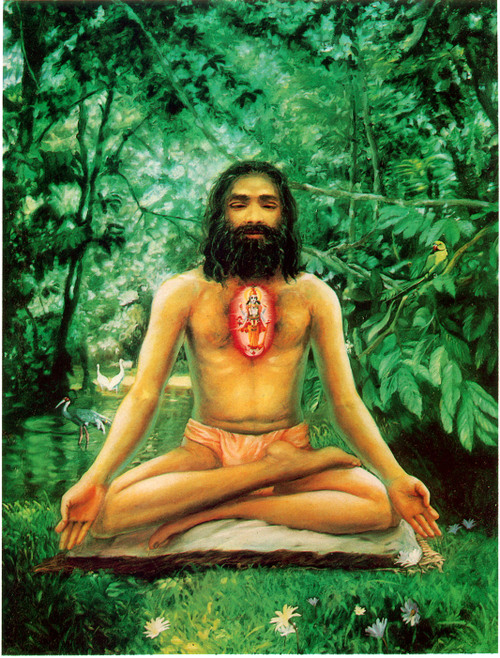
In his purport to verses 13 and 14 of the sixth chapter of Bhagavad Gita as it is, Srila Prabhupada explains that the yoga process is meant to discover the localized form of Vishnu-murti as the Paramatma situated within one’s heart and not for any other purpose. One who has no program to realize this Vishnu-murti form within the heart, Srila Prabhupada says, is certainly wasting his time. Srila Prabhupada also stresses the practice of celibacy or Brahmacharya for realizing this Vishnu-murti form.
In this connection, Srila Prabhupada makes a very important comment – “One cannot enjoy sex life daily at home or elsewhere and attend a so-called yoga class and thus become a yogi”. Only in the bhakti school, Srila Prabhupada says, restrained sex life is allowed for the householder devotees of Krishna who can eventually give it up altogether due to the higher taste that they get in devotional service. In the concluding lines of the purport, Srila Prabhupada laments that the yoga system currently practiced in many yoga societies of the world is quite contrary to that which is outlined by Lord Krishna in these verses of the Bhagavad Gita
Key for success in yoga process ( BG 6.15 – 6.17 )
Regulation holds the key for success in yoga process – Lord Krishna says, “One cannot become a yogi if one eats too much or eats too little, sleeps too much or does not sleep enough. One who is regulated in one’s habits of eating, sleeping, recreation and work can mitigate all material pains by practicing the yoga system”. In his purport to the verse 16 of the sixth chapter of Bhagavad Gita as it is, Srila Prabhupada explains that one who eats for sense pleasure or cooks for himself, not offering his food to Krishna, eats only sin. Moreover, those who indulge in animal meat, drinking and smoking, Srila Prabhupada says, suffer sinful reactions because of eating polluted things. Srila Prabhupada questions as to how one who eats only sin make any progress in the yoga system.
Perfection in the yoga process ( BG 6.18 – 6.28)
Lord Krishna explains the stage of perfection in the process of Ashtanga yoga which is known as Samadhi or trance. In this state, Lord Krishna explains, one can see the self by the pure mind, thereby relish, and rejoice in the self. This state situates the meditator in boundless transcendental happiness that can be realized by one’s transcendental senses. Upon reaching this state, the meditator or the yogi thinks that there is no greater gain and is never shaken even in the midst of the greatest difficulty. In his purport to the verses 20-23 of the sixth chapter of Bhagavad Gita as it is, Srila Prabhupada comments that the state of Samadhi can never be attained by a yogi who indulges in sex and drug intoxication. Following the process of yoga with such indulgence, Srila Prabhupada explains, is a mockery of the yoga process and remains a make-show practice of gymnastic feats. Srila Prabhupada recommends the process of Bhakti yoga or devotional service unto Lord Krishna as the best practice of yoga in modern times. Srila Prabhupada maintains that one can achieve the state of Samadhi and boundless happiness simply by executing the path of Bhakti yoga, which is a simpler and easier path to execute
Vision of a perfected yogi ( BG 6.29 – 6.32 )
Lord Krishna explains the vision of a yogi who has attained perfection. Lord Krishna explains that a true yogi sees Him (Krishna) in all beings and sees all beings in Him (Krishna). Such a pure soul is never lost to Krishna. Such a yogi realizes that Krishna and the Paramatma present in the hearts of all living entities are one and the same
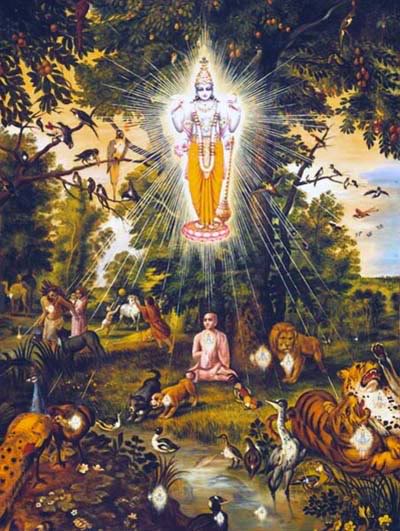
Such a yogi empathizes with all beings in their happiness and distress. In his purport to the verse 29 of the sixth chapter of Bhagavad Gita as it is, Srila Prabhupada carefully explains the difference between the individual soul and the Supersoul (Paramatma). He explains that the individual soul resides in one’s heart but is not present in all hearts. On the other hand, Lord Krishna in the form of the Paramatma or the Supersoul is present in the hearts of all living beings. In his purport to the verse 32 of the sixth chapter of Bhagavad Gita as it is, Srila Prabhupada explains the difference between an Ashtanga yogi and a Bhakti yogi, the devotee of Lord Krishna. He explains that while the Ashtanga yogi has withdrawn himself to a secluded place in pursuit of his own liberation, a Bhakti yogi is very concerned for the welfare of all beings. A Bhakti yogi tries his best to turn every man towards Krishna consciousness
Arjuna rejects Ashtanga Yoga ( BG 6.33 – 6.36 )
After listening to the entire process of Ashtanga yoga from Lord Krishna, Arjuna plainly rejects the process citing his inability to control his restless and unsteady mind. In his purport to the verse 33 of the sixth chapter of Bhagavad Gita as it is, Srila Prabhupada explains that five thousand years ago, Arjuna had much better facilities than we have now and yet, he rejected this yoga process. Srila Prabhupada comments that Arjuna thought it was impossible to follow this yoga system which regulates even the manner of sitting, selection of place and detachment of the mind from material engagements. He concludes that although this yoga process may be possible for very few, it is impossible for people in general. Arjuna further says that controlling the restless, obstinate and strong mind is easier than controlling the wind.
In his purport to the verse 34 of the sixth chapter of Bhagavad Gita as it is, Srila Prabhupada comments that the easiest way to control the mind is to follow the method suggested by Lord Caitanya – to chant the Hare Krishna Mahamantra. Krishna responds to Arjuna’s comments by suggesting that the mind can be controlled by suitable practice and detachment.
In his purport to the verse 35 of the sixth chapter of Bhagavad Gita as it is, Srila Prabhupada comments that the process of hearing about Krishna can enlighten the yogi and detach his mind from activities that hamper his advancement in yoga. Srila Prabhupada also explains the real meaning of Vairagya – detachment of the mind from matter and its attachment to Krishna.
Srila Prabhupada concludes this section of the sixth chapter by a brilliant comment in his purport to the verse 36 of the sixth chapter of Bhagavad Gita as it is – “A Krishna conscious person easily achieves the result of yoga practice without separate endeavor, but a yoga practitioner cannot achieve success without becoming Krishna conscious”.
Destination of an unsuccessful yogi ( BG 6.37 – 6.46 )
Arjuna then asks Krishna about the destination of an unsuccessful yogi or a transcendentalist who fails to attain perfection in his endeavors in yoga. In his purport to verse 37 of the sixth chapter of Bhagavad Gita as it is, Srila Prabhupada comments that to pursue the transcendental path is more or less to declare war on the illusory energy which tries to capture the yogi with various allurements.
Arjuna further enquires whether an unsuccessful yogi falls away from both material and spiritual positions, with no position in any sphere. In his purport to the verse 38 of the sixth chapter of Bhagavad Gita as it is, Srila Prabhupada comments that bhakti yoga is the direct and super-most path of transcendental realization while the paths of Brahman and Paramatma realizations take many births for attaining perfection.
Krishna responds to Arjuna’s enquiries by explaining that a transcendentalist engaged in auspicious spiritual activities does not meet with destruction either in this world or in the spiritual world. In his purport to the verse 40 of the sixth chapter of Bhagavad Gita as it is, Srila Prabhupada comments that activity in Krishna consciousness is the only auspicious activity while those who are interested only in the inauspicious tendencies of eating, sleeping, mating and defending perpetually remain in material existence.
Further, Krishna explains the fate of two kinds of unsuccessful yogis –
(1) one who falls down after short yoga practice
(2) one who falls down after long yoga practice.
Those who fall down after short yoga practice first go to the higher planets and then, take birth in the families of righteous brahmanas or rich aristocratic classes. A yogi who falls down after long yoga practice takes birth in a family of transcendentalists – especially those of the Acaryas or Goswamis. Srila Prabhupada comments that a child born in such families receives a spiritual impetus from the very beginning of its life. Lord Krishna explains that a yogi born in such blessed families revives the divine consciousness of his previous lives and tries to make further progress in order to achieve complete success.
In his purport to verse 43 of the sixth chapter of Bhagavad Gita as it is, Srila Prabhupada cites the example of Bharat Maharaja who took two more births before he achieved perfection. In his purport to verse 44 of the sixth chapter of Bhagavad Gita as it is, Srila Prabhupada cites the example of Thakura Haridasa, a disciple of Lord Caitanya who constantly chanted the Holy Names of Krishna. Srila Prabhupada explains that one cannot take to the principles of Krishna consciousness or chant the Holy Names without being sufficiently purified and having passed through all the ritualistic methods of the Vedas in previous lives. Just before he concludes the discussion on Ashtanga Yoga, Lord Krishna declares that a yogi is greater than the ascetic, the empiricist and the fruitive worker. In his purport to the verse 46 of the sixth chapter of Bhagavad Gita as it is, Srila Prabhupada mentions that the process of Yoga praised by Lord Krishna here is nothing but Bhakti Yoga.
Most searched terms
- Bhagavad gita Chapter 6 Summary
- Bhagavad Gita Chapter 6 Summary ISKON
- Dhyana Yoga summary
- Summary of Bhagavad gita
Conclusion ( BG 6.47 )
Bhakti Yoga or Krishna consciousness is the ultimate perfection of all yogas Lord Krishna concludes his discussion on Yoga by explaining that one who always abides in Him (Krishna) with great faith, always thinks of Him (Krishna) within himself and renders transcendental loving service to Him (Krishna) is the highest of all Yogis.
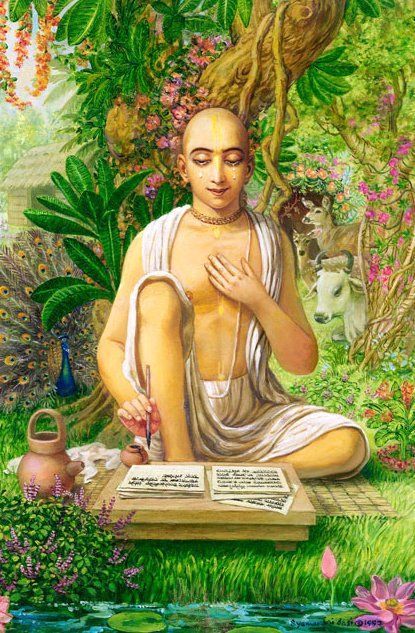
Such a Yogi is said to be the most intimately united with Krishna in Yoga. In his purport to verse 47 of the sixth chapter of Bhagavad Gita as it is, Srila Prabhupada explains that the culmination of all kinds of yoga practices lies in Bhakti Yoga. He further explains that all other yogas are progressions towards the destination of Bhakti Yoga – all other yogas are but means to come to the point of Bhakti in Bhakti Yoga. He concludes by saying that Bhakti Yoga is the ultimate goal, but to analyze Bhakti Yoga minutely, one may need to understand the other Yoga systems such as Karma Yoga, Jnana Yoga and Ashtanga Yoga.
Most Searched Keywords:
- Summary of the Bhagavad Gita – Chapter Six
- Bhagavad Gita Commentary Chapter 6
- The Yoga of Meditation
- Bhagavad Gita Course Chapter 6
- Bhagavad Gita Chapter 6 Dhyana Yoga
- Leadership Lessons from the Bhagavad Gita


